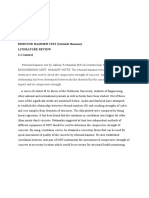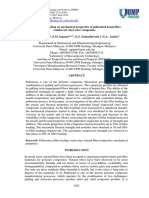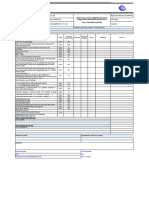Engineered Wood Wood Fibers Particle Board Medium-Density Fiberboard Hardboard
Engineered Wood Wood Fibers Particle Board Medium-Density Fiberboard Hardboard
Uploaded by
asdfghjklCopyright:
Available Formats
Engineered Wood Wood Fibers Particle Board Medium-Density Fiberboard Hardboard
Engineered Wood Wood Fibers Particle Board Medium-Density Fiberboard Hardboard
Uploaded by
asdfghjklOriginal Description:
Original Title
Copyright
Available Formats
Share this document
Did you find this document useful?
Is this content inappropriate?
Copyright:
Available Formats
Engineered Wood Wood Fibers Particle Board Medium-Density Fiberboard Hardboard
Engineered Wood Wood Fibers Particle Board Medium-Density Fiberboard Hardboard
Uploaded by
asdfghjklCopyright:
Available Formats
Chapter 2
REVIEW OF RELATED LITERATURE AND STUDIES
2.1 Theoretical Background
This section focus on different studies identified with examinations both inside and outside the
country which contain fundamental data that can be improved as part of the undertaking. Reasonable
writing originates from various sources for example, articles, research journals, books, magazine,
feasibility studies and web materials. Ideas, approach, subjects and instrumentations that will be
improved with the present study will be analyzed. Furthermore, construction of outline was taken from
the past studies identified with the undertaking.
2.2 Related Literature and Studies
2.2.1 Acoustical Fibreboard
Fiberboards is often used in furniture industry. It is a composite wood that produced by
binding fibers or particle together with adhesives. Typically it is made from wood fibers but there are
studies that ….. Fiberboards has many to offer and it is used in many residential and commercial
buildings. Its application includes soundproofing, structural coverings, and low slope roofing.
Fiberboard is a type of engineered wood product that is made out of wood fibers. Types of
fiberboard (in order of increasing density) include particle board or low-density fiberboard
(LDF), medium-density fiberboard (MDF), and hardboard (high-density fiberboard, HDF).
It is sometimes used as a synonym for particle board, but particle board usually refers to low-density
fiberboard. Plywood is not a type of fiberboard, as it is made of thin sheets of wood, not wood fibers
or particles. Fiberboard, particularly medium-density fiberboard, is heavily used in
the furnitureindustry. For pieces that will be visible, a veneer of wood is often glued onto fiberboard
to give it the appearance of conventional wood.
In the packaging industry, the term "fiberboard" is often used to describe a tough kraft-
based paperboard or corrugated fiberboard for boxes.[1]
"Fiberboard" is also an intermediate product, an output of a pulp mill used as input for a paper mill.
Engineered wood, also called composite wood, man-made wood, or manufactured
board, includes a range of derivative wood products which are manufactured by binding or fixing the
strands, particles, fibres, or veneers or boards of wood, together with adhesives, or other methods of
fixation[1] to form composite materials. These products are engineered to precise design specifications
which are tested to meet national or international standards. Engineered wood products are used in a
variety of applications, from home construction to commercial buildings to industrial products.[2] The
products can be used for joists and beams that replace steel in many building projects.[3]
Typically, engineered wood products are made from the
same hardwoods and softwoods used to manufacture lumber. Sawmill scraps and other wood waste can
be used for engineered wood composed of wood particles or fibers, but whole logs are usually used for
veneers, such as plywood, MDF or particle board. Some engineered wood products, like oriented strand
board (OSB), can use trees from the poplar family, a common but non-structural species.
Alternatively, it is also possible to manufacture similar engineered bamboo from
bamboo; and similar engineered cellulosic products from other lignin-containing materials such
as rye straw, wheat straw, rice straw, hemp stalks, kenaf stalks, or sugar cane residue, in which case
they contain no actual wood but rather vegetable fibers.
Flat pack furniture is typically made out of man-made wood due to its low
manufacturing costs and its low weight.
Medium-density fibreboard, is made by breaking down hardwood or softwood
residuals into wood fibres, combining it with wax and a resin binder, and forming panels by applying
high temperature and pressure.
Particle board – also known as particleboard, low-density fibreboard (LDF),
and chipboard – is an engineered wood product manufactured from wood chips, sawmill shavings,
or even sawdust, and a synthetic resin or other suitable binder, which is pressed
and extruded.[1] Oriented strand board, also known as flakeboard, waferboard, or chipboard, is
similar but uses machined wood flakes offering more strength. All of these are composite
materials[2] that belong to the spectrum of fiberboard products.
Medium-density fibreboard (MDF) is an engineered wood product made by breaking down
hardwood or softwood residuals into wood fibres, often in a defibrator, combining it with wax and
a resin binder, and forming panels by applying high temperature and pressure.[1] MDF is generally
denser than plywood. It is made up of separated fibres, but can be used as a building material
similar in application to plywood. It is stronger and much denser than particle board.[2]
The name derives from the distinction in densities of fibreboard. Large-scale production of MDF
began in the 1980s, in both North America and Europe.
Particle board is cheaper, denser and more uniform than conventional wood and plywood and is
substituted for them when cost is more important than strength and appearance. However,
particleboard can be made more attractive by painting or the use of wood veneers onto surfaces that
will be visible. Though it is denser than conventional wood, it is the lightest and weakest type of
fiberboard, except for insulation board. Medium-density fibreboard and hardboard, also called high-
density fiberboard, are stronger and denser than particleboard. Different grades of particleboard
have different densities, with higher density connoting greater strength and greater resistance to
failure of screw fasteners.
A major disadvantage of particleboard is that it is very prone to expansion and discoloration due to
moisture, particularly when it is not covered with paint or another sealer. Therefore, it is rarely used
outdoors or in places where there are high levels of moisture, with the exception of some bathrooms,
kitchens and laundries, where it is commonly used as an underlayment - in its moisture resistant
variant - beneath a continuous sheet of vinyl flooring.
The advantages of using particleboard over veneer core plywood is it is more stable (unless it gets
wet), much cheaper to buy, and somewhat more convenient to use.
Hardboard, also called high-density fiberboard (HDF),[1] is a type of fiberboard, which is
an engineered wood product. [2]
It is similar to particle board and medium-density fiberboard, but is denser and much stronger and
harder because it is made out of exploded wood fibers that have been highly
compressed.[3] Consequently, the density of hardboard is 31 lbs or more per cubic foot
(500 kg/m³)[4] and is usually about 50-65 lbs per cubic foot (800–1040 kg/m³).[citation needed] It differs from
particle board in that the bonding of the wood fibers requires no additional
materials,[5] although resin is often added. Unlike particle board, it will not split or crack.[citation needed]
Hardboard has long been used in furniture, but it is also popular for use in the construction industry
and with trades as a temporary floor protector. Hardboard has become less popular over recent
years due to new environmental targets in the construction industry[6] to procure more sustainable
temporary protection materials.
Hardboard is produced in either a wet or dry process. The wet process, known as the Mason
Method,[7] leaves only one smooth side while the dry processed hardboard is smooth on both
sides. Masonite is produced using the wet process only.
You might also like
- Concrete Epoxy HV PDFDocument2 pagesConcrete Epoxy HV PDFGeovanni Mabiscay50% (2)
- Natural Fiber-Reinforced CementDocument10 pagesNatural Fiber-Reinforced CementJohn Ray CuevasNo ratings yet
- Light Transmitting ConcreteDocument19 pagesLight Transmitting ConcreteSurabhi AnandNo ratings yet
- Concrete Creep ModelsDocument18 pagesConcrete Creep ModelsLesego MatojaneNo ratings yet
- Makalah Mata Kuliah Struktur Kayu: "Wood-Based Composites and Panel Products"Document11 pagesMakalah Mata Kuliah Struktur Kayu: "Wood-Based Composites and Panel Products"Achsan Nur CholisNo ratings yet
- Chemical Composition and Mechanical Properties of Basalt and Glass FibersDocument8 pagesChemical Composition and Mechanical Properties of Basalt and Glass Fibersveera999saiNo ratings yet
- Chapter 1Document11 pagesChapter 1asdfghjklNo ratings yet
- Acoustic Textiles Sound Absorption PDFDocument10 pagesAcoustic Textiles Sound Absorption PDFashwin61No ratings yet
- Natural Fiber Polymer CompositesDocument13 pagesNatural Fiber Polymer Compositesessa527No ratings yet
- FINAL-PROPOSAL Need Revisions Fire RatingDocument30 pagesFINAL-PROPOSAL Need Revisions Fire RatingMeister MJNo ratings yet
- Chicken Eggshell Waste As An Additive Component To ParticleboardDocument38 pagesChicken Eggshell Waste As An Additive Component To ParticleboardElijah Maningo•No ratings yet
- SBS Basalt 101Document4 pagesSBS Basalt 101kelvinyeohNo ratings yet
- Noise Reduction Coefficient of Recycled Textile and Waste Paper Composite As Compared To Rigid Polyurethane FoamDocument6 pagesNoise Reduction Coefficient of Recycled Textile and Waste Paper Composite As Compared To Rigid Polyurethane FoamJohn Mark TicarNo ratings yet
- Unit-1 Lecture - 2 Light Weight Construction Materials by Brig. S.K. SharmaDocument14 pagesUnit-1 Lecture - 2 Light Weight Construction Materials by Brig. S.K. SharmaTHE NORTHCAP UNIVERSITYNo ratings yet
- Superstrong Material - BioSteelDocument22 pagesSuperstrong Material - BioSteelDIPAK VINAYAK SHIRBHATE100% (1)
- Thermal Properties of Hemp and Clay Monolithic Walls - Busbridge - RhydwenDocument8 pagesThermal Properties of Hemp and Clay Monolithic Walls - Busbridge - RhydwenRuth BusbridgeNo ratings yet
- Properties and Use of High-Density Fiberboard HighDocument6 pagesProperties and Use of High-Density Fiberboard HighSanyam SuranaNo ratings yet
- Nanocomposite PDFDocument16 pagesNanocomposite PDFRahul YadavNo ratings yet
- Natural Fiber ReinforcedDocument7 pagesNatural Fiber ReinforcedMohammedAL-AthariNo ratings yet
- Hemp in Construction - Shanaka2Document31 pagesHemp in Construction - Shanaka2kbkshanakaNo ratings yet
- Composite Board Chapter 1 3Document17 pagesComposite Board Chapter 1 3Mary Bernadeth S. PeligresNo ratings yet
- Sheep Wool ConcreteDocument10 pagesSheep Wool Concretesharin vargheseNo ratings yet
- Plastic Aggregates Use in Hallow BlocksDocument12 pagesPlastic Aggregates Use in Hallow BlocksEdison KingNo ratings yet
- Derivates of Keratine GODDART & MICHAELISDocument12 pagesDerivates of Keratine GODDART & MICHAELISLex SuárezNo ratings yet
- Title of ResearchDocument6 pagesTitle of ResearchNkem OkonkwoNo ratings yet
- Development of Hybrid Fibrous Panel For Controlling Acoustics in Home Theatre Conference HallDocument10 pagesDevelopment of Hybrid Fibrous Panel For Controlling Acoustics in Home Theatre Conference HallEditor IJTSRDNo ratings yet
- Tensile and Flexural Properties of Areca Sheath FibersDocument9 pagesTensile and Flexural Properties of Areca Sheath FibersDr. Srinivas Chikkol VenkateshappaNo ratings yet
- Thermal Decomposition Study of Silica Phenolic 1Document8 pagesThermal Decomposition Study of Silica Phenolic 1Kishore ShanmugavelNo ratings yet
- Literature Review and ConclusionDocument12 pagesLiterature Review and ConclusionHaiqal RafiqNo ratings yet
- Experimental Study of Waste Chicken Feather Fibre in ConcreteDocument4 pagesExperimental Study of Waste Chicken Feather Fibre in ConcreteEditor IJTSRDNo ratings yet
- Eco-Boards: A Green Building Material From Residues and WasteDocument26 pagesEco-Boards: A Green Building Material From Residues and WasteJaybesNo ratings yet
- Notes On The Plastic IndustryDocument14 pagesNotes On The Plastic IndustryIvandale GundranNo ratings yet
- A Review On Use of FRP Mesh and Bamboo Fiber Composite Material For AAC Block Masonry Wall Strengthening and WaterDocument5 pagesA Review On Use of FRP Mesh and Bamboo Fiber Composite Material For AAC Block Masonry Wall Strengthening and WaterIJRASETPublicationsNo ratings yet
- Areca Reinforced ConcreteDocument54 pagesAreca Reinforced ConcreteAjayakumara K100% (1)
- Biofibres Biodegradable Polymers and Biocomposites An OverviewDocument24 pagesBiofibres Biodegradable Polymers and Biocomposites An OverviewAbdul BasitNo ratings yet
- Light-Weight Honeycomb Core Sandwich Panels Containing Biofiber-Reinforced Thermoset Polymer Composite Skins Fabrication and EvaluationDocument8 pagesLight-Weight Honeycomb Core Sandwich Panels Containing Biofiber-Reinforced Thermoset Polymer Composite Skins Fabrication and EvaluationEdemNo ratings yet
- 2013 - Recycling Glass Fibre Reinforced Composites - History and ProgressDocument5 pages2013 - Recycling Glass Fibre Reinforced Composites - History and ProgressSubramani PichandiNo ratings yet
- Classifications of Synthetic Organic AdhesivesDocument6 pagesClassifications of Synthetic Organic AdhesivesJanna Jaiya MeowNo ratings yet
- Green Composite ManufacturingDocument19 pagesGreen Composite ManufacturingDelovita GintingNo ratings yet
- Structural Use of Expanded Polystyrene ConcreteDocument8 pagesStructural Use of Expanded Polystyrene ConcreteInternational Journal of Innovative Science and Research TechnologyNo ratings yet
- Cardboard (Paper Product) : HistoryDocument4 pagesCardboard (Paper Product) : Historydulyu4uNo ratings yet
- Synthetic MaterialsDocument11 pagesSynthetic Materialsrock0% (1)
- Lec-6 Building Materials - TimberDocument25 pagesLec-6 Building Materials - TimberMr. Shahriar MahmudNo ratings yet
- BindersDocument4 pagesBindersSariyyaHeydarovaNo ratings yet
- Advantages and Limitations of FRPDocument4 pagesAdvantages and Limitations of FRPWolfMensch1216No ratings yet
- Literature Review FormatDocument7 pagesLiterature Review FormatNur HazimahNo ratings yet
- Class NoteDocument67 pagesClass NoteSujan SinghNo ratings yet
- 111Document24 pages111giovanniNo ratings yet
- 14.analysis of Epoxy Resin With Natural MaterialsDocument7 pages14.analysis of Epoxy Resin With Natural MaterialsRavi CNo ratings yet
- KrausMaffei IMM BR FiberForm enDocument12 pagesKrausMaffei IMM BR FiberForm enkikorrasNo ratings yet
- Recycling of Textile Wastes Into Textile CompositeDocument8 pagesRecycling of Textile Wastes Into Textile Compositeİrem Nur YükselNo ratings yet
- Diferent Material Use in Product DesigningDocument29 pagesDiferent Material Use in Product Designingapi-26570979100% (3)
- Wood Plastic Composite Report by Darshan RN and Sagar Balayya SanddiDocument28 pagesWood Plastic Composite Report by Darshan RN and Sagar Balayya SanddiDarshanNo ratings yet
- Calcium Additive Into PultrusionDocument12 pagesCalcium Additive Into PultrusionIan LeeNo ratings yet
- Fibre Reinforced ConcreteDocument11 pagesFibre Reinforced Concretesyedqumbar100% (1)
- Thermal Insulation Materials A Tool For Energy Conservation 2157 7110 1000670Document4 pagesThermal Insulation Materials A Tool For Energy Conservation 2157 7110 1000670hiren13183No ratings yet
- Module 2 PDFDocument98 pagesModule 2 PDFPrathmesh Bharuka100% (1)
- Experimental Study On Hybrid Fiber Concrete With Banana and Sugarcane FiberDocument10 pagesExperimental Study On Hybrid Fiber Concrete With Banana and Sugarcane FiberInternational Journal of Application or Innovation in Engineering & ManagementNo ratings yet
- Pulp and Paper 1Document11 pagesPulp and Paper 1Caren ReasNo ratings yet
- Comprative Study of Enset and Banana FiberDocument7 pagesComprative Study of Enset and Banana FiberbiniyamNo ratings yet
- Functional and Physical Properties of Polymer NanocompositesFrom EverandFunctional and Physical Properties of Polymer NanocompositesAravind DasariNo ratings yet
- Developmental Reading Portfolio: Juan Dela CruzDocument4 pagesDevelopmental Reading Portfolio: Juan Dela CruzasdfghjklNo ratings yet
- Materials:: Deck, Metal, 20 GageDocument2 pagesMaterials:: Deck, Metal, 20 GageasdfghjklNo ratings yet
- Load Live Load: Material SpecificationDocument3 pagesLoad Live Load: Material SpecificationasdfghjklNo ratings yet
- Experiment No. 5 "Sieve Analysis Aggregates": College of EngineeringDocument7 pagesExperiment No. 5 "Sieve Analysis Aggregates": College of EngineeringasdfghjklNo ratings yet
- Geologic Time Scale REVIEWERDocument11 pagesGeologic Time Scale REVIEWERasdfghjkl100% (1)
- Surface Repair Using Form-and-Pour Techniques: Reported by ACI Committee E 706Document7 pagesSurface Repair Using Form-and-Pour Techniques: Reported by ACI Committee E 706Carlos Gonzalez100% (1)
- Advantages of Pre Stressed ConcreteDocument2 pagesAdvantages of Pre Stressed Concreteatharvasaxena93No ratings yet
- The Strength of ConcreteDocument7 pagesThe Strength of Concretedelhoum sohaibNo ratings yet
- Sika Admixutures PDFDocument2 pagesSika Admixutures PDFDaisy PaulNo ratings yet
- CBM Unit 3 Composite Materials 1Document122 pagesCBM Unit 3 Composite Materials 1francy sharonNo ratings yet
- Rate Analysis For PCCDocument2 pagesRate Analysis For PCCAsif100% (1)
- Oval DPR Overall For NGN ProjectDocument4 pagesOval DPR Overall For NGN ProjectRashmi Ranjan MohantyNo ratings yet
- One Way and Two Way SlabDocument46 pagesOne Way and Two Way SlabMohit DhimanNo ratings yet
- Definisi - Prinsip Beton PrategangDocument42 pagesDefinisi - Prinsip Beton PrategangGufron FitrionoNo ratings yet
- Top View Kitchen: Keterangan FinishingDocument2 pagesTop View Kitchen: Keterangan Finishingmaratur rohmaniaNo ratings yet
- Moment Coefficient Tables PDFDocument13 pagesMoment Coefficient Tables PDFSamiullah100% (2)
- Beams InvestigationDocument45 pagesBeams InvestigationNikka KayeNo ratings yet
- Precast Brochure B37Document4 pagesPrecast Brochure B37ashfaq afzalNo ratings yet
- Meena Bhagat, Ramya Raju Jimit Chotai: Fly Ash Concrete: A Technical Analysis For Compressive StrengthDocument5 pagesMeena Bhagat, Ramya Raju Jimit Chotai: Fly Ash Concrete: A Technical Analysis For Compressive StrengthVIVA-TECH IJRINo ratings yet
- Is 1343-2012-Code of Practice For Pre Stressed ConcreteDocument69 pagesIs 1343-2012-Code of Practice For Pre Stressed ConcreteShankar L DhaasharathNo ratings yet
- Types of CracksDocument14 pagesTypes of Cracksasl halNo ratings yet
- p27 PDFDocument1 pagep27 PDFmr. oneNo ratings yet
- S2-3 - PT Transfer - Almila UzelDocument25 pagesS2-3 - PT Transfer - Almila UzelChien KsNo ratings yet
- POW AS ON 01 April 2021Document177 pagesPOW AS ON 01 April 2021harish choudharyNo ratings yet
- Chapter 12 CompositesDocument40 pagesChapter 12 CompositesAbood AtiyatNo ratings yet
- Komposisi Amp Dan Pemakaian BahanDocument15 pagesKomposisi Amp Dan Pemakaian Bahanaswin andreasNo ratings yet
- ប្លង់ផ្ទះល្វែងDocument41 pagesប្លង់ផ្ទះល្វែងdiamondNo ratings yet
- Gujarat Technological University: W.E.F. AY 2018-19Document3 pagesGujarat Technological University: W.E.F. AY 2018-19Shah ChintanNo ratings yet
- Concrete Mix Design Proposal Mix - 33Document3 pagesConcrete Mix Design Proposal Mix - 33Ruwan Sampath WickramathilakaNo ratings yet
- Working of MivanDocument5 pagesWorking of MivanAnuja Jadhav100% (1)
- Prestressed General Principles PDFDocument7 pagesPrestressed General Principles PDFNani CherryNo ratings yet
- Project: Exedy New Factory & Office SUBJECT: Compressor, Air Dryer & Pump PoundationDocument7 pagesProject: Exedy New Factory & Office SUBJECT: Compressor, Air Dryer & Pump PoundationsarkimankimanNo ratings yet
- ACI 212.3R-91 Chemical Admixtures For ConcreteDocument31 pagesACI 212.3R-91 Chemical Admixtures For Concretepanjol CivilNo ratings yet






























































































